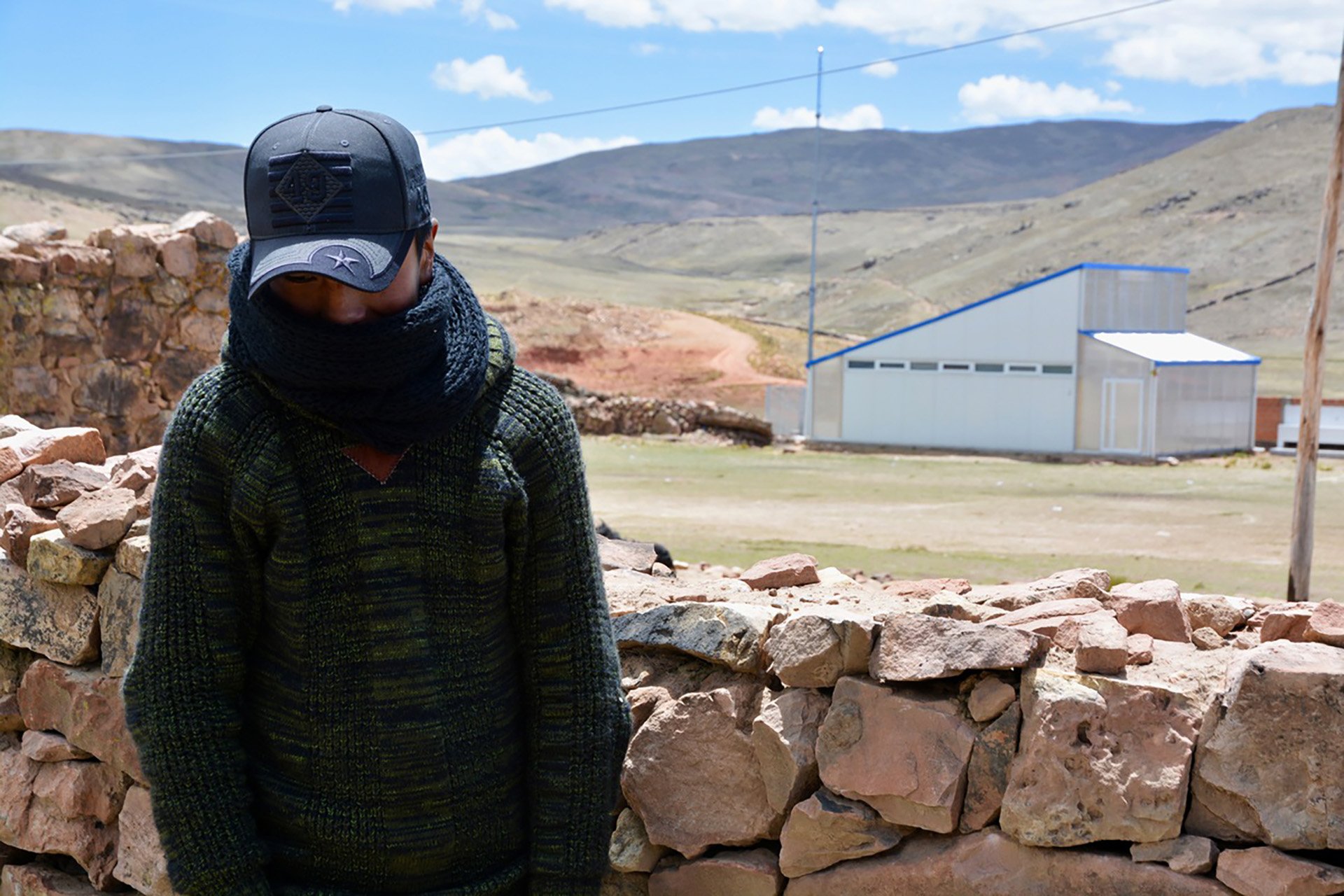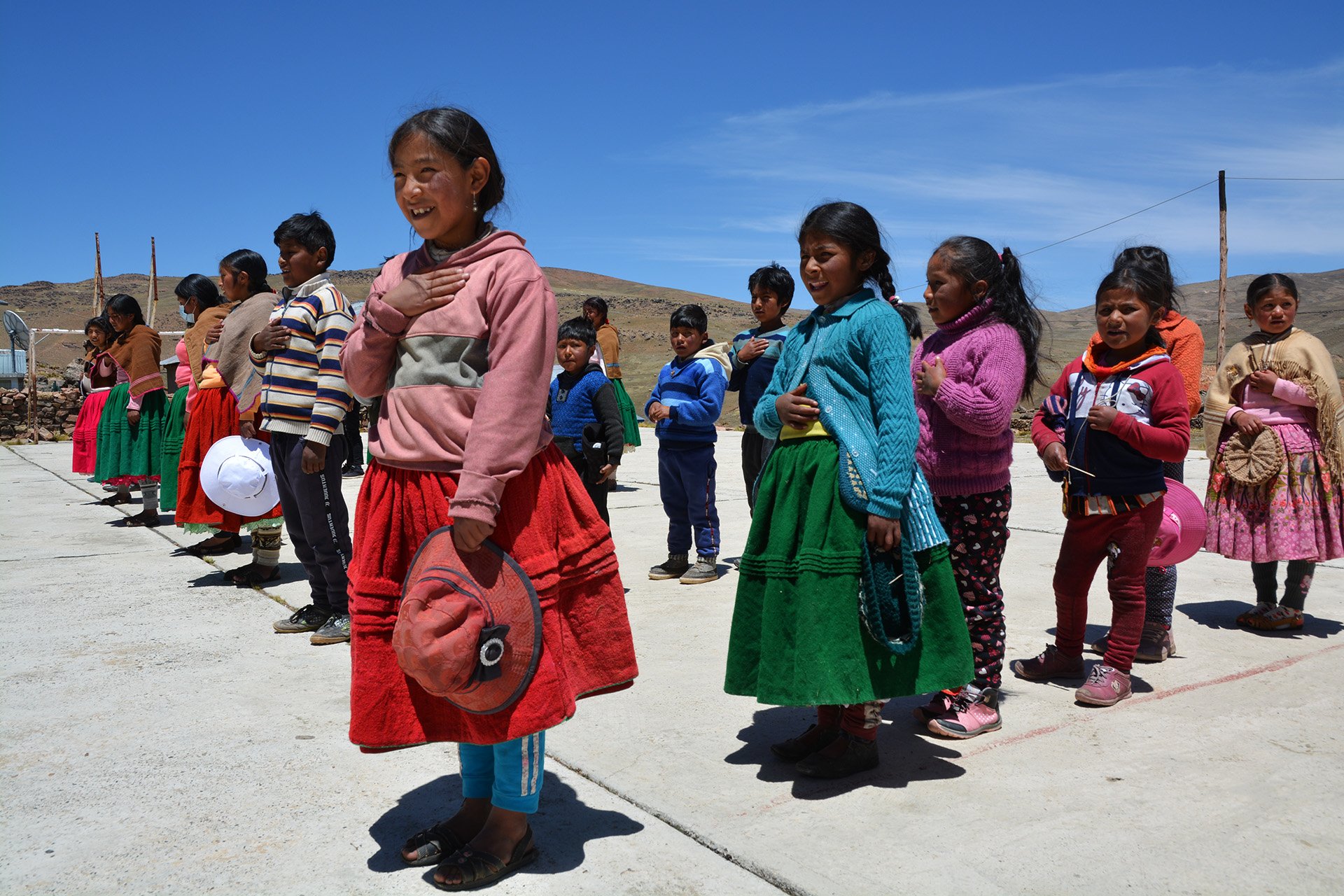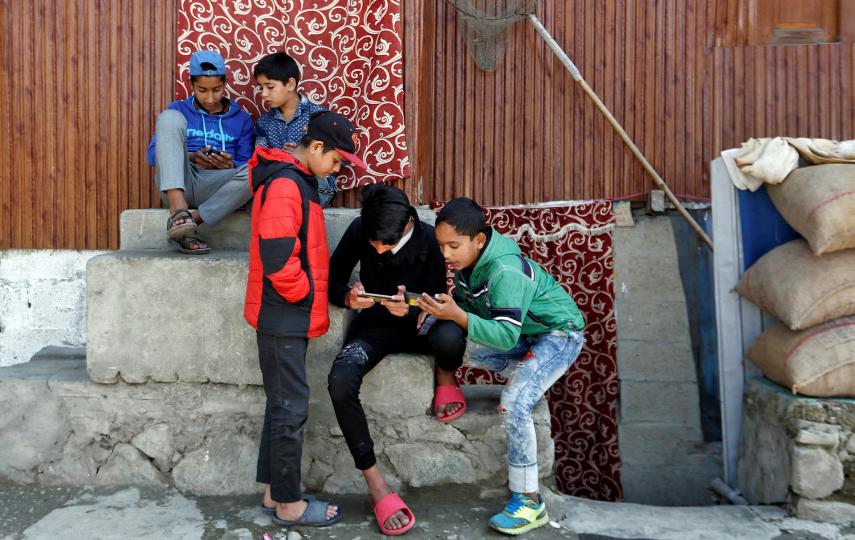A dirt road is the only way to reach the remote Peruvian village of Tarucani, located high in the vast arid plains of the Andes, where pink flamingos paddle shallow brooks along the Bolivian border and herds of alpacas forage the dry and sparse vegetation for the few edible morsels.
The village has little connection to the outside world: The nearest market town is an hour away by four-wheel drive, and the only means of transportation is a pair of motorbikes, apparently shared by the roughly 200 Indigenous Aymara people who live here.
Even before the pandemic, government nurses only came to Tarucani once every two weeks, so when The New Humanitarian visited in October 2021 it was no surprise to discover that the vaccination campaign had not yet begun.
However, it was a side-effect of the pandemic, not the dangers of the virus itself, that most concerned the village’s residents: None of María Luisa Espejo Vargas’s six children – aged 4 to 18 – have had any consistent schooling for almost two years.
Espejo Vargas, 38, has done her best to improvise. She scraped together enough money to buy a cell phone so her eldest son could follow his courses online – even though the village rarely has electricity and the signal is sporadic at best.
But when the phone broke, she couldn’t afford a new one. Her son had to wait for over a year with no lessons at all before a new teacher was deployed to the village to resume limited in-person classes – a compromise negotiated by regional governments to try to stop students in rural areas from falling too far behind.
By the time classes resumed – only two days a week and combining children of all age groups – most students had forgotten what they had previously learned.
Most residents of Tarucani are illiterate. The village has long been denied basic services – from education and health programmes to electricity and phone connections. Its small school – previously run by a resident teacher who left early in the pandemic – only opened in 2005.
“I am very sad,” Espejo Vargas told The New Humanitarian. “I don’t want them to end up like me,” she said, tears streaming down her cheeks. “I want them to study and have a profession. I want them to be more than alpaca herders.”
‘A real crisis of equity’
From a brief look at UNESCO’s map showing the total duration of school closures due to the pandemic, the current education crisis would seem to be a fairly evenly spread global phenomenon, but this would be to ignore the disparities that lie beneath the surface.
In the developed world, virtual online lessons quickly replaced in-person classes, whereas many schools and children in the Global South lacked the computers, broadband connections, or simply the means to make these possible. As students return to school slickly in wealthy countries after the holidays, tens of millions of children in poorer regions are still facing partial school closures or disruption due to the lingering effects of the pandemic.
Read more → Why we Rohingya want to save our refugee-run schools
“While the impacts of the pandemic [on education] have been universal, they have not been uniform,” explained Save the Children’s Head of Education Policy James Cox, adding that children in marginalised areas – like the poverty-stricken villages of the Andes – have been hit the hardest. “It is a real crisis of equity,” he said.
The scale of the education losses – especially when you take into account their knock-on effects in existing crisis settings – have far-reaching consequences, not only for the children themselves but also for the humanitarian organisations working in those communities.
“I am in a state of panic,” Robert Jenkins, director of education at UNICEF, told The New Humanitarian. “We need to go into crisis footing to respond to this.”
Since the onset of the pandemic, so-called “learning poverty” – the inability of a 10-year-old child to read a basic text – has increased from 50 to 70 percent in low- and middle-income countries.
The disruptive impacts of prolonged school closures mean the setback to children’s learning is longer than simply the time they are out of class – estimates reach as high as an average of 2.8 years of education lost for every year of school closure in sub-Saharan Africa. Cox estimated that some children could lose 20 percent – or more – of their education.
The UN recently warned that impacted children could lose a combined total of $17 trillion in their lifetime earnings – a sharp rise from the 2020 estimate of a $10 trillion loss.
But the school closures have already been impacting children in more tangible ways, too: At the peak of the pandemic, an estimated 370 million children were unable to access school meals, often a steady source of nutrition, worsening food insecurity and malnutrition.
Girls often lost out to boys when it came to accessing technology needed to keep up; a MIET Africa study looking at five different countries across sub-Saharan Africa showed that 23 percent of male teenagers were able to continue their studies through the pandemic without disruptions, compared to only 12 percent of female teenagers.
“Yes, water is important, food is important, tents are important... But if you really want to invest, and want to be honest about local empowerment, you need to invest in human beings.”
Worse still, some children will stay out of school permanently. In Uganda – where classes only restarted last week after reportedly the world’s longest school shutdown – the National Planning Authority estimates that 30 percent of students will not return, due to a combination of teen pregnancies, early marriages, and child labour.
In some parts of the world, the choices are even starker.
Millions of children caught in armed violence, poverty, and hunger in countries like Burkina Faso, Mali, and Niger are forced to pick between education and survival. And since the Taliban takeover, education – particularly for girls – has become increasingly politicised in Afghanistan, where aid groups are struggling to resume assistance amid a complex economic and humanitarian crisis.
“Humanitarian thinking has to shift,” said Yasmine Sherif, director of Education Cannot Wait, an organisation that combines government, humanitarian, and development funds to address education needs in crisis situations. “Yes, water is important, food is important, tents are important,” she told The New Humanitarian. “But if you really want to invest, and want to be honest about local empowerment, you need to invest in human beings.”
According to Education Cannot Wait, only 2.6 percent of global humanitarian funding was earmarked for education in 2019, a number Sherif estimates should be at least 10 percent to ensure access to safe, free, and quality education. In 2020, the proportion remained roughly the same as at pre-pandemic levels. To put this in context, programmes to improve food security received 22 percent of humanitarian spending the same year.
“How do you best invest in human beings? You allow them to be educated,” Sherif said. “Humanitarians think about emergencies, but it is not about quick fixes only.”
The rise in child labour
Peru has easily the highest COVID-19 death rate per capita in the world, and the country has been hit hard economically by the pandemic too.
The Peruvian government began reopening bars, gyms, and casinos at the end of 2020, but it took another year for the Ministry of Education to announce its plans to resume daily in-person classes, making Peru one of the slowest countries globally to do so.
The loss of learning has had a disastrous impact on children in rural, impoverished communities like Taracuni, where many see this as part of an ongoing cycle of being abandoned by a government whose officials rarely – if ever – visit.
“Politicians have forgotten us,” said Horacio Quispe Chambi, the teacher who drives six hours from his home in the regional capital, Puno, to Tarucani to teach the twice-a-week classes in Taracuni. “They just think about themselves, and not about the reality of people living in the countryside.”
One of the realities Quispe Chambi has observed is an uptick in child labour, which increased globally for the first time in two decades during 2020, when many children from poor families had to help out parents who had lost their jobs due to the pandemic.

“I needed to get a cell phone [to study remotely],” said Frank Christian Mamani Ramírez, a 14-year-old from Tarucani, explaining why he went to Bolivia to work in an illegal gold mine when school was suspended. There, he earned a monthly salary of 350 Peruvian soles (roughly $90) – poverty wages.
“Four other Peruvian boys were at the mine, and they stayed longer,” he said. While Mamani Ramírez hopes to attend university someday, he said he would voluntarily return to the mining work if he needed more money.
Many of Quispe Chambi’s students have also gone to Bolivia's legislative capital, La Paz, in search of work, or to San Juan del Oro and Puerto Maldonado in the Peruvian Amazon – known for their illicit coca production and illegal gold mining.
“We feel the absence of our students,” Quispe Chambi said. “Because of the situation due to the pandemic, we cannot develop the curricula that our students need to learn.”
Reduced budgets, and aid cuts
Although there is a growing awareness of the crisis, humanitarians are concerned that two thirds of developing countries have cut their education budgets amidst pandemic-induced downturns.
“There is a great political reiteration of the importance of education,” Save the Children’s Cox said, cautioning that government budgets have shrunk due to COVID-related recessions, meaning that education funding has fallen across the board.
Some Western donors who were once education champions are not funding as many initiatives as in the past: Britain recently announced cuts in funding for girls’ education in developing countries, while Norway’s new government subsequently halved a pledge that could affect some 2.4 million children.
“The critical point now is that we formulate strategies and do not sacrifice education.”
“We are fearful that short-term budgetary challenges will compromise the medium- and long-term potential of each child to realise their dreams," UNICEF’s Jenkins said.
Nevertheless, 11 African leaders committed to spend 20 percent of their budgets on education during a recent summit co-hosted by Britain and Kenya to raise funds for the Global Partnership for Education (GPE), a move Cox sees as a positive step in the right direction.
“The critical point now is that we formulate strategies and do not sacrifice education,” he stressed.
Solutions that can work everywhere
Humanitarians are urging a holistic, tailored approach as governments and aid groups attempt to mitigate both the short-term and long-term impacts of education losses around the globe.
“Differentiate and accelerate: this is needed more than ever,” said Jenkins, arguing that it is critical that children are individually assessed according to their abilities, and that students, parents, and teachers are all offered the support they need.
While many propose technology – both access to it and training on how to use it – as part of the solution, there is also a recognition that it is no panacea and that it needs to be accompanied by more comprehensive learning recovery plans.
A joint December report by UNICEF, UNESCO, and the World Bank recommended that it was essential that schools reopen as quickly as possible and remain open. Once this happens, curricula should be consolidated to prioritise essential learning even if it means combining classes – particularly in earlier years – to ensure pupils grasp foundational maths and literacy. Teaching time may be extended, especially in summer months, while teachers should be trained to target needs more efficiently, “aligning instruction to students’ learning level”.
“If education has no connectivity aspect and [children] don’t know how to use the internet, they are just not going to be there, even if we are reaching them with some quality of education,” Gary Stahl, UNICEF’s director of private sector fundraising and partnerships, told The New Humanitarian.
Stahl was speaking from a sustainable finance summit in Geneva, where he was promoting Giga, an initiative launched with the International Telecommunication Union (ITU) to connect schools to the internet in light of the COVID-19 pandemic.

However, in Tarucani and other remote conflict or poverty-stricken settings, laptops and iPads aren’t always the most effective solution.
“If I go to the mountains in Afghanistan, [technology] is not the solution,” said Sherif, explaining that – as is the case in the Andes – the lack of electricity and internet access would present a challenge. However, she pointed out that investing in cell phones could go a long way in refugee camps, where large families often share a single smartphone.
Holistic solutions, experts said, must also enhance access to a wide range of educational services – from school meals to psychosocial and mental health support.
“Even from an educational perspective, it is critical that children are well-nourished, feel safe, and have a sense of protection,” Jenkins said, mentioning that UNICEF is working in partnership with the World Food Programme (WFP) to try to address these needs.
Back in Tarucani, this all seems a long way off.
Residents are still waiting to see whether the Peruvian government will keep its promise of resuming full-time in-person education for children in rural areas at the end of March. Many are nervous. A small rented building that was being used as the makeshift school might be taken back by its owner. And with Omicron cases mounting, compliance with social-distancing protocols may present yet another hurdle.
“We have been very worried,” said Quispe Chambi. “The pandemic is detrimental to our students and complicates the situation. Right now, the teaching they are receiving is not enough.”
The New Humanitarian used transportation provided by Puno regional government officials. Edited by Anna Lekas Miller.





